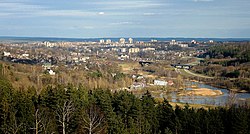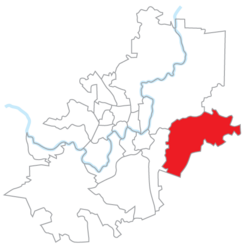Naujoji Vilnia
Naujoji Vilnia | |
|---|---|
 Naujoji Vilnia as seen from surrounding hills | |
 | |
| Country | |
| County | |
| Municipality | Vilnius city municipality |
| Area | |
| • Total | 39.3 km2(15.2 sq mi) |
| Population (2023) | |
| • Total | 42,545 |
| • Density | 1,100/km2(2,800/sq mi) |
| Time zone | UTC+2(EET) |
| • Summer (DST) | UTC+3(EEST) |
Naujoji Vilniais aneldershipin easternVilnius,Lithuaniasituated along the banks of theVilnia River.According to the 2011 census, the district had a population of 31,933.[1]This figure grew to 36,507 in 2021, when the newest census was performed. The ethnographic composition is very diverse, but is also changing because of construction boom inPavilnysandKalnėnaineighborhoods of Naujoji Vilnia.
History
[edit]



New Vileika emerged as a separate town in the second half of the 19th century when theWarsaw – Saint Petersburg Railwaywas built. It grew as a narrow strip along the rails. Then another majorLibau–Romny Railwayline connecting Vilnius withMinskwas built. BeforeWorld War I,Naujoji Vilnia was one of the mostindustrializedcities inLithuania,growing to 10,300 inhabitants in 1903, one of the largest in Lithuania at the time (comp. toAlytuswith 3,445,Marijampolėwith 6,777 orPanevėžyswith 12,968 inhabitants in 1897). It had a number ofmetalandwood manufacturingfactories,yeast,scythes,knives, paper and knitting mills.
In 1878,industrialistsWyszwianski and Szereszewski hailing fromBerlincame to Naujoji Vilnia and established a German-Russiannailfactory with 90 workers. In 1882, the factory was bought by the wealthiest man inLübeckof the timeEmil Possehl.Additionally, 60 specialists fromStyriawere invited to work at theplant.Raw materials, from which scythes were produced were from Emil Possehl's steel factory inSweden.In 1886, 1 million scythes were produced a year. In 1900 scythes produced in Naujoji Vilnia were demonstrated atThe 1900 World's Fair in Paris.In 1905 there were 450 laborers working in thefactory.BeforeWorld War I,already more than 3 million scythes were produced at the factory annually. Thescythesandnailfactory in Naujoji Vilnia was the largest in theWorldat the time.[2][3]
In 1911,The Church of St. Casimirwas built.
Duringmass deportations to Siberiain June 1941, some 30,000 deportees passed through theNaujoji Vilnia railway station.AfterWorld War II,former shops were nationalized by the Soviet authorities and converted into large factories for machine tools, agricultural equipment and other factories. In 1957 it was incorporated into Vilnius city.
In May 1991, pro-Sovietpoliticians associated withYedinstvounilaterally proclaimed the illegal establishment of the so-calledPolish National-Territorial Region,projected in the ethnically-mixedVilnius Regiondistrict just outside of Vilnius, complete with its own flag, anthem, bank and the "capital" at Naujoji Vilnia. In August of the same year Lithuanian authorities cracked down on these actions asseparatistsin the area had supported the failedAugust Putschin Moscow.
Demographics
[edit]During the last two decades between the 2001 and 2021 censuses, the percentage of Lithuanians grew from 29,5% to 47,9% (17,493 persons), while the percentage ofPolesshrank from 34,2% to 26,4% (9,646 inhabitants),Russians— from 19,8% to 13,3% (4,858 persons),Belarusiansfrom 9% to 5,8% (2,105 inhabitants),Ukrainians— from 1,5% to 1,1% (390). There were also 2,008 inhabitants of other ethnicity.
Notable people
[edit]- Tadeusz Konwicki,Polish writer
Twin towns
[edit]Footnotes
[edit]- ^"Vilniaus apskritis (Vilnius county), 2011 Census".Lietuvos statistikos departamentas.
- ^Didžiausias pasaulyje dalgių fabrikas – tik viena Naujosios Vilnios įdomybė
- ^Dalgių fabrikas
References
[edit]- Simas Sužiedėlis, ed. (1970–1978). "Naujoji Vilnia".Encyclopedia Lituanica.Vol. IV. Boston, Massachusetts: Juozas Kapočius. p. 52.LCCN74-114275.
